Here’s A Fluffy German Cheesecake Made From Fresh Quark!
Want a cheesecake that is fluffy and creamy with a hint of lemon zest? Our German Cheesecake recipe is for you!
Known as Käsekuchen in German (literally cheese + cake), this German-style cheesecake – made from quark – is the perfect dessert for any occasion.
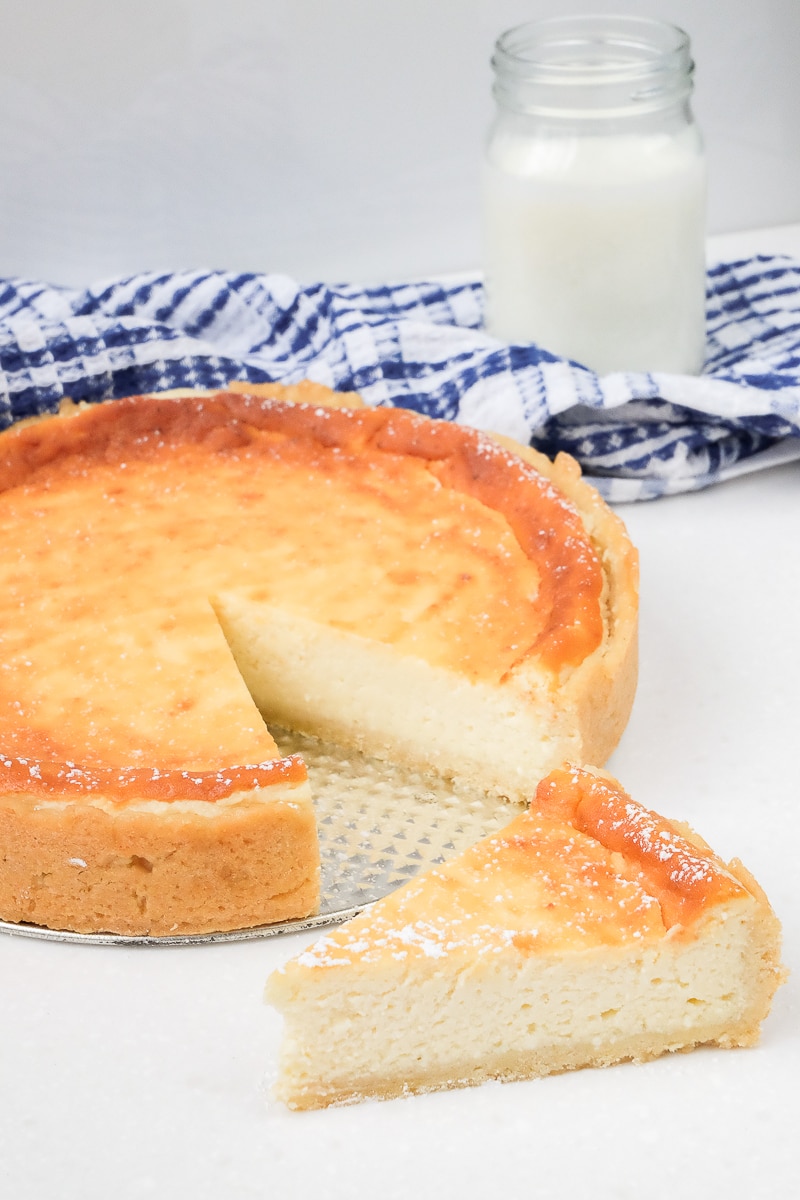
Now, some of you may be asking: What’s quark? Quark is a dairy product similar to cottage cheese or yogurt… but it’s actually neither of those.
Quark is a staple in German baking and cooking. We have our own quark recipe because it’s almost impossible to get in North America.
Quark is only really found in Germany, Austria, and Switzerland. So it’s great that it can be made at home using just two ingredients – buttermilk and normal dairy milk.
In any case, the quark in the German cheesecake makes the final product lighter and fluffier on the inside than you might be used to from an North American cheesecake.
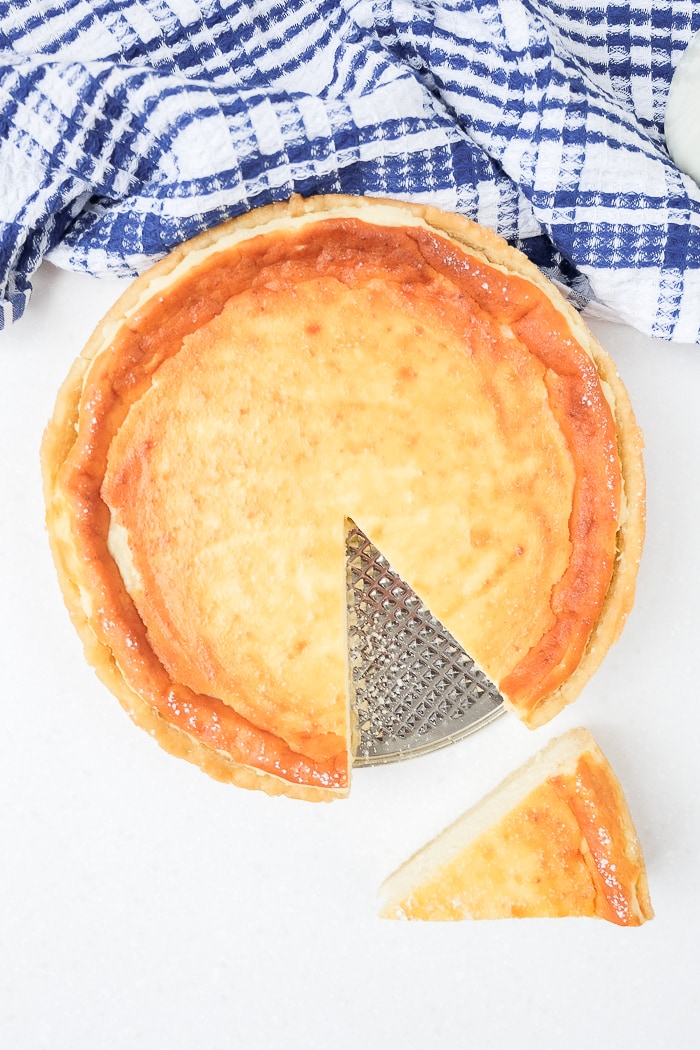
If you can’t find quark and don’t want to make your own, you could substitute for Greek yogurt. However, a true German-style cheesecake is made with quark!
That said, there are a few different variations of German cheesecake.
While they are all made with quark, you can have a crust-less version (no crust up the sides). This just means you adjust the ingredients for the dough to make less of it.
You could also add some mandarin oranges into the filling which is a popular addition for German cheesecake. However, unlike North American cheesecake German cheesecake is usually not topped with any additional fruit before serving.
All we did was a light dusting of powdered sugar and it was great! This allows you to actually taste the sweetness and the creaminess.
Looking for more German cake recipes? Try our marble cake, apple cake with streusel topping, classic butter cake, or a no-bake chocolate cake!
German Cheesecake vs New York Cheesecake
So, how does a quark cheesecake compare to another style of cheesecake – like a New York style? This is a popular question.
The main differences between German cheesecake and New York Cheesecake are really just the type of crust, the type of cheese/dairy used, and as a result of that, the overall texture.
New York Cheesecake is made with cream cheese which creates a much denser, richer, and smoother filling when baked.
German cheesecake is traditionally made with German quark which (as we have mentioned) is a dairy product like yogurt or soft cheese but not really either one.
Quark cheesecake ends up very light and fluffy in texture but still extremely creamy.
Another difference – depending on which cheesecake recipe you follow – is the crust. For North American cheesecake, people often use a soft graham cracker crumble for the crust.
German cheesecakes are usually a simple crust made with butter and flour. However, sometimes you can also find a buttery crust on the New York-style cheesecake. You can even find a type of sponge crust on some classic cheesecakes in New York.
How to Make German-style Cheesecake – Step-by-Step
If you’re looking to make a classic German-style cheesecake, you can check out the recipe card in the bottom of this post for all the ingredients and instructions.
In case you are more of a visual learner, you can follow along with our cheesecake process photos. This way, you can get a sense of how you’re doing and whether your creation looks like ours!
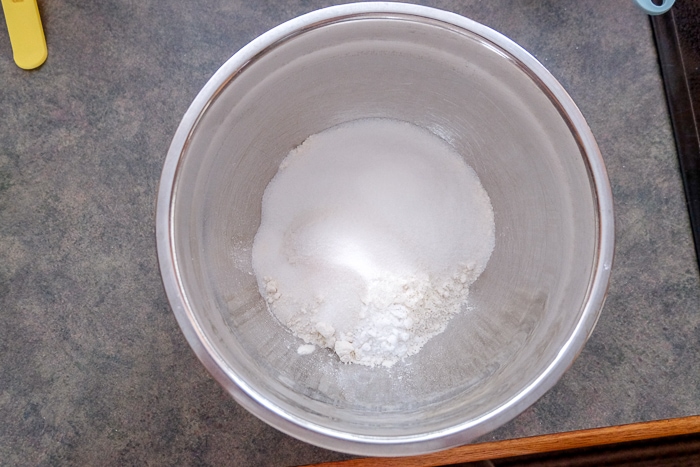
First, we’ll make the dough. For this, add the flour, sugar, salt, and baking powder to a medium-sized bowl.
Give everything a stir with a spoon.
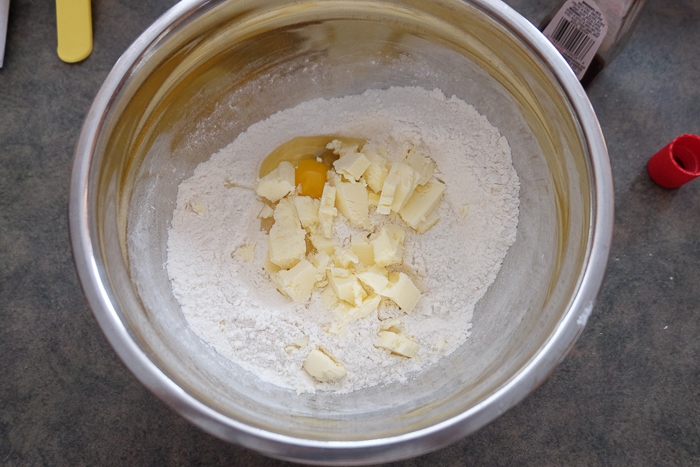
Cut up the cold butter into small cubes and add them to the bowl. Also, add the egg and the vanilla extract.
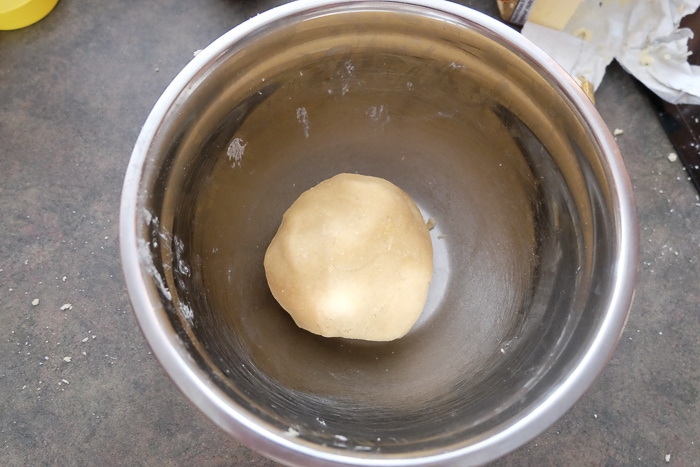
Mix everything with the spiral dough hooks of your electric mixer or your clean hands until the dough is well combined and easily forms a small ball.
Cover the bowl with a lid or cling film and place it in the fridge.
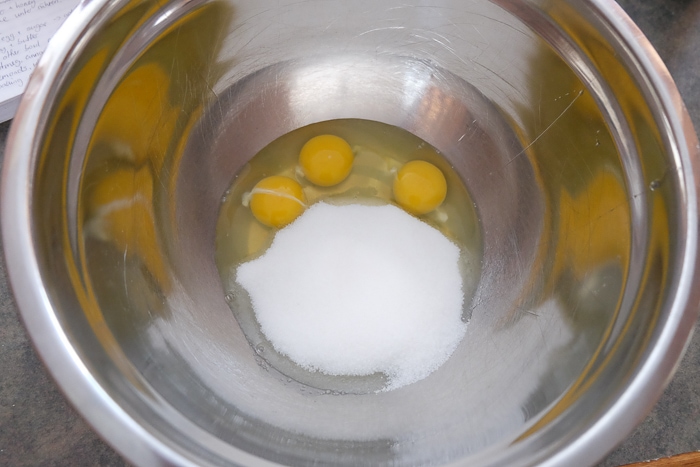
Next, we’ll make the filling. For that, take a large bowl and add the eggs as well as the granulated sugar.
Use the normal beaters of your electric mixer to mix the eggs and sugar until you have a creamy mixture.
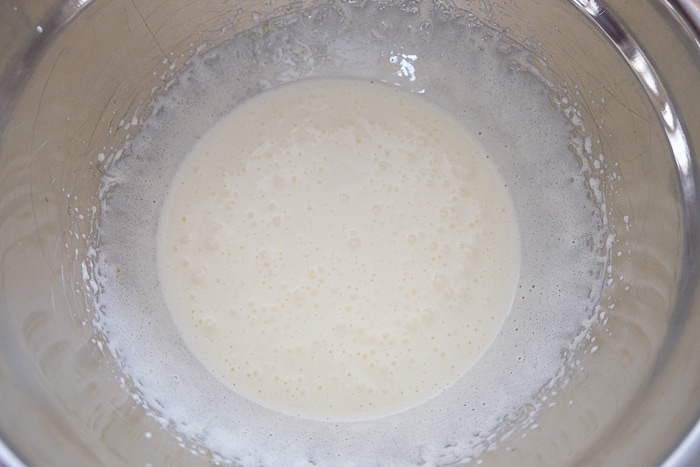
Keep mixing, until the mixture is light in color and looks creamy (and maybe has a few bubbles).
Then add the pudding powder and vanilla extract and mix again. Finally, also add the oil and lemon zest and mix until everything is well combined.
When you are done, set the bowl aside and clean the beaters of your electric mixer.
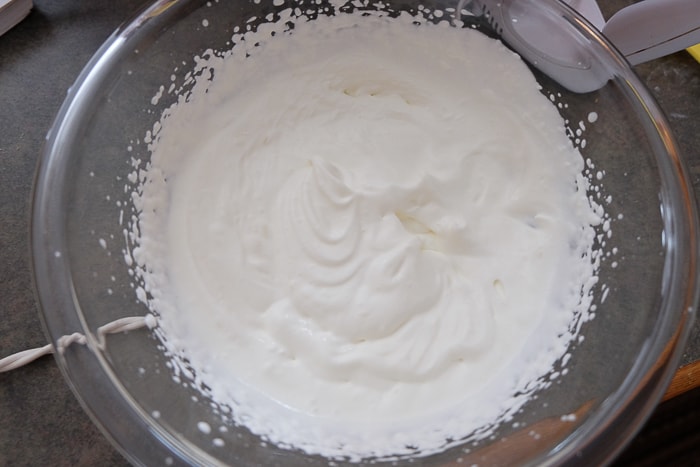
In yet another bowl, whip the cream with the clean beaters of your electric mixer. Then set your mixer aside.
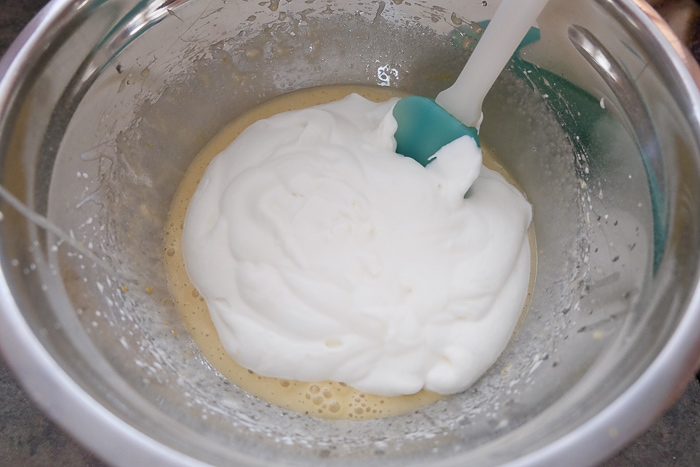
Then carefully fold the whipped cream into the bowl with egg-sugar-mixture using a spatula.
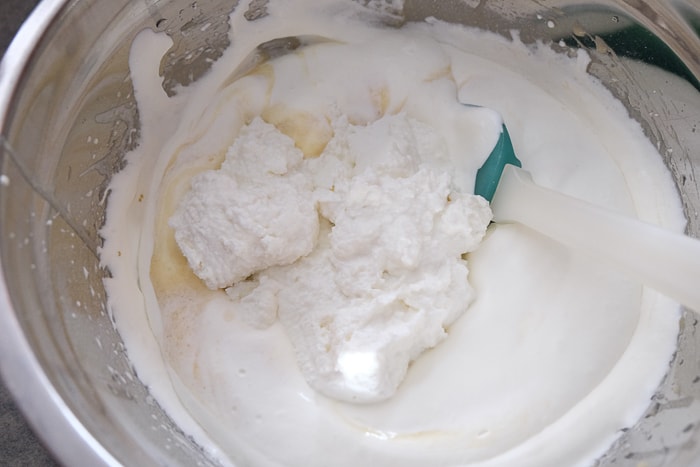
Also add the quark and keep folding with your spatula until the mixture is well combined. As mentioned above, it is easy to make your own quark at home.
However if you are in a time crunch you could try making the recipe with Greek yoghurt or similar. (We can’t give any guarantees that it will turn out as great though).
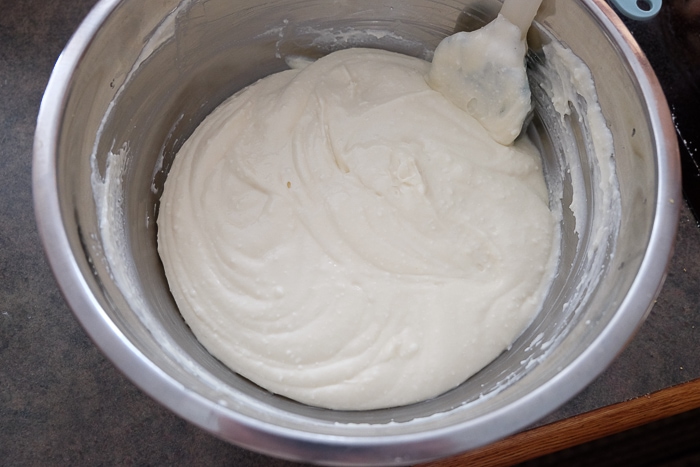
When everything is well mixed it should have an even color and look similar to the photo above. Once you are happy with your filling, set the bowl aside.
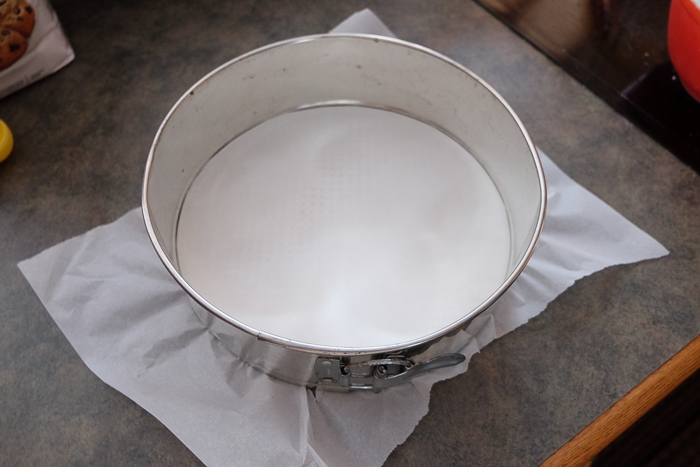
Line the bottom of your 9 1/2 inch springform pan with parchment paper can lightly grease the sides.
At this time also preheat your oven to 330 degrees Fahrenheit.
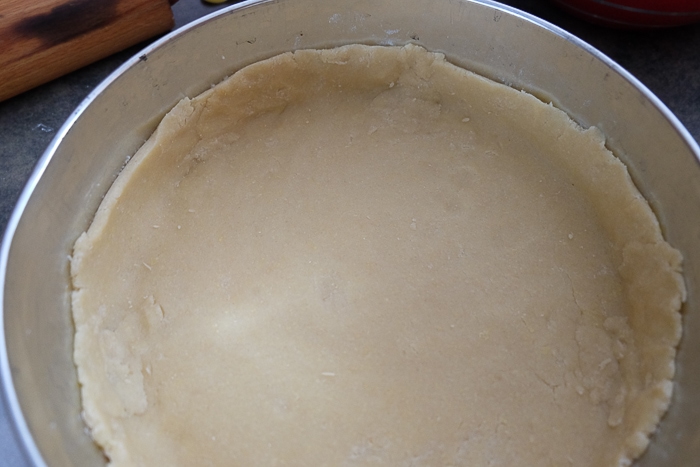
Remove the dough from the fridge and sprinkle some flour onto your countertop. Roll out your dough with a rolling pin until it is a little bit bigger than your springform pan.
Lift the rolled out dough and place it into the pan. Press it into place slightly. You should have a crust of approx. 1 inch going up the sides.
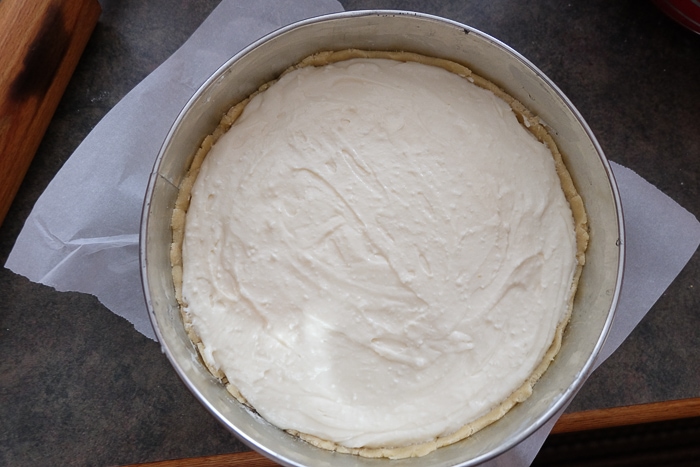
Now pour the filling onto the dough in the pan and make sure it is evenly distrubuted. You can use a large spoon or spatula to do that.
Bake the cake on the lower third of your oven for 60 to 70 minutes. Once baked, remove the cheesecake from the oven and let it fully cool in the pan before removing the ring.
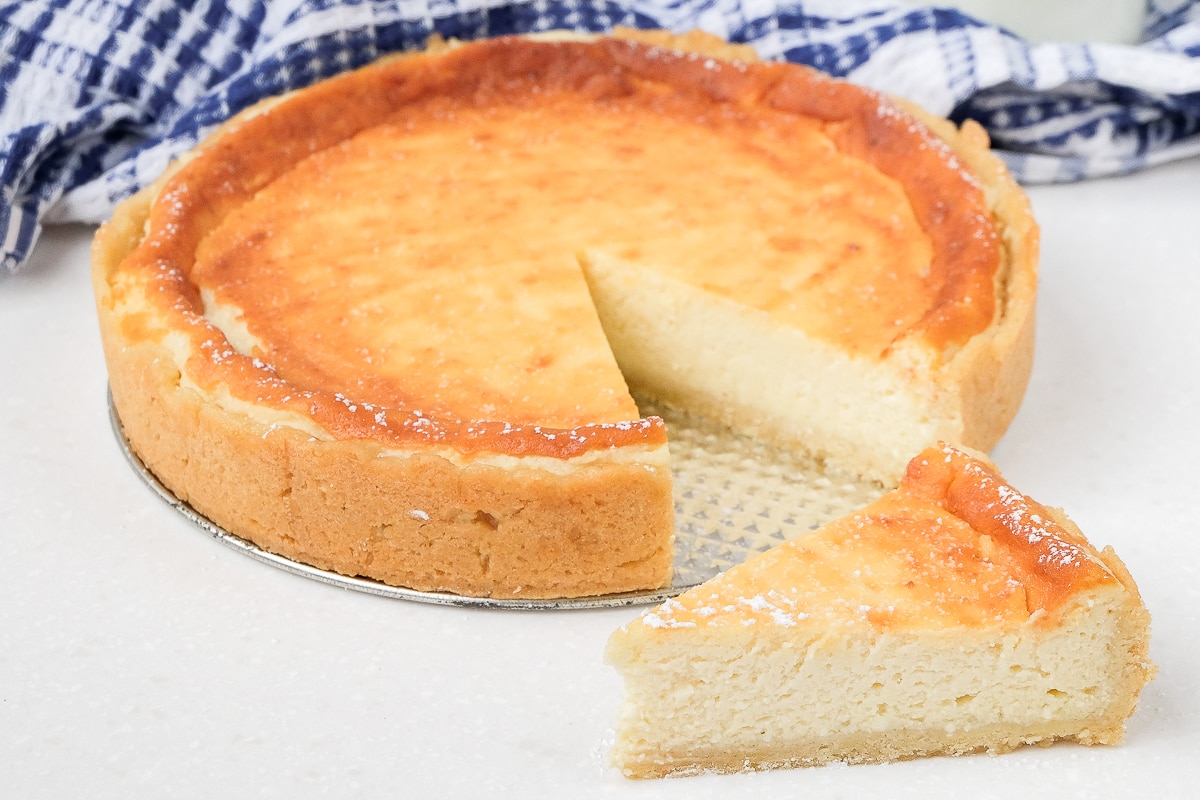
You can dust your cheesecake with powdered sugar before serving (this is completely optional). We hope you enjoy our Käsekuchen recipe!
Storage Tips
Store the cooled cheesecake or any leftovers in an airtight container in the fridge. You should consume it within three to four days.
Alternatively, you can also freeze slices of the cheesecake.
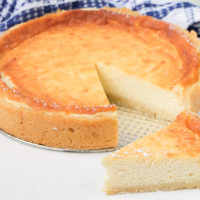
German Cheesecake (Käsekuchen)
Ingredients
The Dough
- 1 1/3 cups all-purpose flour
- 1/3 cup granulated sugar
- a pinch of salt
- 1/2 teaspoon baking powder
- 1 medium-sized egg
- 1/2 teaspoon vanilla extract
- 1/2 cup butter, cold
The Filling
- 1 cup granulated sugar
- 3 medium-sized eggs
- 2 cups Quark, see notes
- 1 package instant pudding powder, vanilla (approximately 1/2 cup)
- 1 teaspoon lemon zest
- 1 teaspoon vanilla extract
- 1/2 cup vegetable oil
- 3/4 cup whipping cream
Instructions
The Dough:
- Add the flour, sugar, salt, and baking powder into a medium-sized bowl and give everything a stir with a spoon.
- Cut up the cold butter into small cubes and add them into the bowl. Also, add the vanilla extract and the egg into the bowl.
- Mix everything with the spiral dough hooks of your electric mixer or your clean hands until the dough is well combined and forms a ball. Cover the bowl with cling film and place it in the fridge.
The Filling:
- In a separate large bowl, mix the eggs with the sugar using the normal beaters of your electric mixer until you have a creamy mixture. Add the pudding powder and vanilla extract and mix again until everything is well combined. Then add the oil and the lemon zest and mix again.
- In another bowl, whip the cream using clean (!) beaters of your electric mixer.
- Fold the whipped cream and quark into the mixture in the large bowl little by little using a spatula or large spoon. Make sure everything is well combined and there are no lumps. Set the mixture aside.
The Assembly:
- Line the bottom of your 9 1/2 inch springform pan with parchment paper and grease the sides. Also preheat the oven to 330 degrees Fahrenheit.
- Take out the dough from the fridge and sprinkle your countertop with a little bit of flour. Roll out your dough using a rolling pin until it is just a bit larger than your springform pan. Place the rolled out dough into the pan and press it into place. You should have a crust of approx. 1 inch going up the sides of the pan.
- Once your crust is fitted well, pour the filling into the pan and make sure it is evenly distributed using a spatula or spoon.
- Bake the cake in the lower third of your oven for 60-70 minutes. Remove the cake from the oven and let it cool fully before removing the ring of the springform pan. You can dust the cheesecake with powdered sugar before serving (optional).
Notes
- Traditionally, German cheesecake is made with quark, a dairy product that can often only be found in Germany, Austria, and Switzerland. Unfortunately, it can be extremely difficult to buy it in North America. If you want to make a truly authentic German cheesecake, you can make your own quark (we usually do this) by following our homemade quark recipe. Alternatively – if you are short on time -, you could also try making this recipe with Greek yogurt or similar.
- Store (the leftovers of) your cooled cheesecake in an airtight container in the fridge. Consume it within three to four days. Alternatively, you can also freeze slices of the cheesecake.
Nutrition
This nutritional information has been estimated by an online nutrition calculator. It should only be seen as a rough calculation and not a replacement for professional dietary advice.
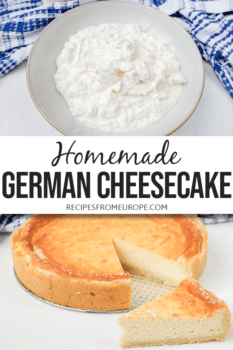
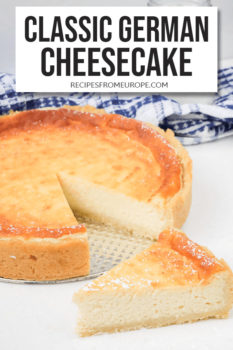

All LIDL supermarkets have the Quark in Italy. Only LIDL has.
That’s good to know, thanks for sharing Sergio!
Thank you, I have a similar recipe I got from my friend in Germany and it is the best cheesecake you can do or buy!! Sergio from Italy 🙂
How much of the powdered vanilla pudding do you add? Is it added dry or actually made into pudding when you add it? I can buy it in packets I need to know how much powder to add to batter/filling. Also I remember getting this cheesecake in a square configuration. Can it be baked in a cake pan? Thanks
Hi Margaret, I’m adding one packet of dry vanilla pudding powder to the cheesecake, which equals about 1/2 cup of pudding powder. Please add it in the powder form.
In general, you can also make a baking sheet version of German-style cheesecake. Make sure you use a baking sheet with high sides and don’t add dough for a along the sides of the pan, just cover the bottom. The baking time will likely vary and I am not sure if the ingredient amounts listed here would be sufficient for a baking sheet version… I’ll have to test that before I can make more specific recommendations. /Lisa
since quark is expensive and not available where I live, I mix cream cheese and cottage cheese 50/50. Plus you don’t need pudding, I use 2 tbsp of Atta flour and end up having fiber in the cake. I also add raisins, it is how they make it in Croatia.
Thanks for sharing Slavica, that sounds tasty! /Lisa
Any thoughts on making this without eggs? We have a strict veg in the family and I wanted this to work for everyone. I understand I could use egg substitutes but wanted your thoughts if you had other suggestions.
Hi Lisa ,
Instead of Greek yogurt , can I use 2 tubs of16oz each Fage 5% ?
Karin
Hi Karin, I would say yes, but with a slight * since I have never used it personally and don’t know the exact consistency first hand (if it’s similar to other brands of Greek yogurt, I don’t see a problem).. it doesn’t seem to be available in my regular grocery stores. Sorry I can’t be more helpful! /Lisa
Can I add fruit to the filling? Like fresh peaches?
Sorry about that it’s definitely 5 Stars!!!!!!
You can definitely add fruit to the filling. Canned peaches or canned mandarin oranges are common additions to German cheesecake – just make sure to drain them well. Now that I think about it, I’ve never used fresh peaches before, but I’m not really sure why because it should work. I would just make sure to use ripe peaches. You can either put them in the filling (I would add half the filling to the springform pan, then add some fruit and then the rest of the filling) or you can bake the cake without the fruit, let it cool and then garnish with fruit after (you’d have to use some cake glaze with that, which can be difficult to find sometimes depending on where you are). I hope that helps a bit! /Lisa
Whyever do you want to use a pre-made pudding powder? This has put me off this recipe.
I’m using pudding powder because it is a classic ingredient in lots of German cheesecakes. It’s used to “stabilize” the filling. If you don’t want to use pudding powder, I understand – you could try using semolina, flour or cornstarch instead. There are also lots of great recipes for cheesecakes out there where it’s not an ingredient.
How much cornstarch could you use instead of the pudding powder?
Typically you can use it in a 1:1 ratio, so in this case you could use about 1/2 cup of cornstarch…but I have not personally tried making this particular cake with cornstarch, so I would err on the side of caution and maybe use a little less so the flavor is not too noticeable. I’ll have to try making it with cornstarch to confirm. Sorry I can’t be more helpful currently! /Lisa
Bird’s has no sugar, but Dr. Oetker has lots. Is adjustment needed? Thanks.
Absolutely love this recipe! I think a little less sugar for next time but that’s my personnel preference, my hubby thought it was perfect just the way it was.
The recipe states you may freeze slices. Has anyone attempted freezing the entire cake?
Thanks for the kind feedback, Brigitte – I’m glad it was a hit! And yes, next time you can just add a bit less sugar now that you know. I’ve never tried freezing a whole cheesecake since I usually don’t have enough room in my freezer but maybe somebody else can chime in. /Lisa
The dough didn’t want to roll out and its way to lemony, but otherwise its good
The lemon zest is definitely personal preference, in my family we’ve always enjoyed the lemon flavor. Thanks for mentioning it though, it might be helpful for others who don’t enjoy the taste. Could you elaborate on what the problem was with the dough so we can troubleshoot? Did the dough stick to the rolling pin? Then putting the dough back into the fridge for a bit and/or using some flour on the rolling pin can help. Did the dough crumble when rolling it out? It might have been too cold. Briefly kneading it with your hands to warm it up a bit can help. Unfortunately this type of dough can sometimes be a bit finicky. Hope that helps! /Lisa
I made a cake yesterday. After 65 minutes toe filling seemed to be very wet. I baked for another 20 minutes and it was setting up. After it cooled it was very very good but only bout 1 inch thick. Would the filling have firmed up on cooling after 70 minutes?
Hi Alan, it’s hard to say with certainty from a distance (not knowing how hot your oven cooks and the form you used), but typically the cheesecake gets a lot firmer as it cools. It’s important to let it cool fully before removing the springform pan or cutting it. Next time you can also try this: After you turn off the oven, let the cheesecake sit in the oven with the oven door open until it is fully cooled. That will also help solidify it a bit more!
I have cooked my cheesecake for 70 minutes but it is very loose. Should it solidify after or do I need to cook longer?
The cheesecake will get firmer as it cools. After you turn off the oven, you can let the cheesecake sit in the oven with the oven door open until it is fully cooled. That will also help solidify it a bit more!
I’ve been using a recipe for German Cheesecake which included quark and cream cheese (I used Mascarpone). At first it seemed fine but lately it does seem a bit too dense, so I’m looking forward to trying this recipe. I’m in Poland and don’t think I can buy whipping cream here, at least not the stuff I used in England. I can get 12% 15% and 30% sour cream here. There is also sweet cream ( śmietanka} but not sure if that thickens up like whipping cream. Would any of these be suitable please? Thanks.
Hi Eileen, unfortunately I don’t have personal experience cooking with Polish cream. After doing a bit of research śmietanka seems like it should work. When making cheesecake here in Canada, I use 35% whipping cream and I see that śmietanka is available as 36% so maybe give that a try and see if it works! /Lisa
Thank you for your reply. I often shop in Germany and found some ‘Schlagsahne’ which … according to Google translates to Whipping Cream. so here goes -:)
I live in wales UK and am wondering what is pudding powder? in your recipe for german baked cheesecake can l buy it in uk if not is there a substitute? Sandra
Hi Sandra, you could try using Bird’s Instant Custard Powder (approximately 150 grams of it) or another instant custard powder (I’ve seen Tesco sells Instant Custard Mix). I’ve done some research and it seems like the best substitute to pudding powder but I haven’t personally tried it so I can’t guarantee success, unfortunately. Alternatively, you could try finding Jell-O Vanilla Instant Pudding Mix or Dr. Oetker Vanilla Pudding powder at some European deli stores. I hope this helps! /Lisa
Hi Lisa,
Is the pudding powder you use sugar free?
The pudding powder I usually use contains some sugar but I can’t tell you how much exactly. The cake overall turns out quite sweet when using pudding powder with sugar, so you could use sugar-free pudding powder without adjusting the amount of sugar you add to the cake. I wasn’t able to find sugar-free pudding powder yet, but I’ll keep an eye out and try it /Lisa